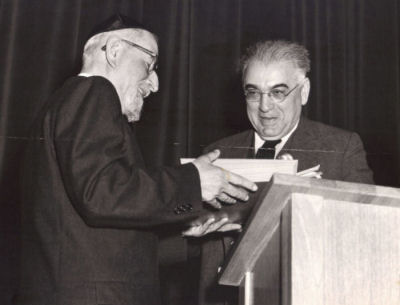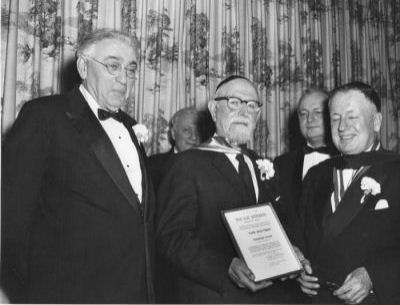|
|
Rabbi Israel Porath and Rabbi Abba Hillel Silver | |
|
Cleveland's
leading Orthodox rabbi and its leading Reform
rabbi |
|
by
Arnold Berger |
|
|
|
|
Rabbis Silver and Porath were often photographed together. Left, in 1958, Rabbi Silver presents a book of certificates for trees in the 10,000 tree Rabbi Israel Porath forest in Israel. Right, in 1962, Rabbi Porath holds his Bar Ilan University Fellowship award for scholarship. Rabbi Silver is at his right. Photo sources: left, Hannah Porath; right, Yehudit Spero |
|
|
Weeks later grandson Paul Porath, in an email from Israel, said he had been at his grandfather's home on Thanksgiving Day in 1963. He wrote "My grandfather was visibly affected when a radio broadcast brought the news of Silver's death". (He had been stricken as the Silver family was sitting down for Thanksgiving dinner. Rushed to Lakeside Hospital by his sons, he died at 3:45 pm.) Then at the home of Hannah Porath, widow of David Porath, the rabbi's youngest child, I saw photos of the two great rabbis seated side by side or standing together at community events. Mrs. Porath said they had officiated together when a child of a Reform family was marrying a child of an Orthodox family. She said Rabbi Porath had gone to Rabbi Silver's funeral. A family member has said that Rabbi Silver contributed funds to help publish Mavo haTalmud, Rabbi Porath's Introduction to the Talmud. Confirmation of such a gift has not been found, but a document in the Porath Archives at the WRHS shows Rabbi Silver serving on the publication committee for one of the volumes, so that is a reasonable conclusion.
When Paul Porath wrote that Abba Hillel
Silver would come to his grandfather's
shul, the Heights Jewish Center,
to say kaddish (the mourner's
prayer) for his parents,
I believed I should offer some reasons
for this relationship. Seven years younger than Israel Porath, Abba Hillel Silver was also a life-long Zionist, attending his first Zionist conference in 1906 when he was just a boy in knickers (see picture). He had risen to the highest levels of Zionist leadership and led the fight for United Nations recognition of the State of Israel.
Silver's roots were
very different from his image.
Yes, he led a congregation founded in
1850 by German Jews that before his
arrival had been one of the most liberal
in the Reform movement. He led services
on Sundays (a custom that began before his
predecessor Rabbi Moses Gries) with
little Hebrew, dressed in formal clothes
and his head bare. |
Few knew he was born in Lithuania and that Yiddish was his first language. In 1902 his mother bought nine year old Abraham and his brother and sisters to New York. (His father had come two years before to work and save to bring his family over.) They lived in near poverty on New York's lower east side. His home was traditional, his father a rabbi who taught in religious schools. "Abe" Silver attended public school in the morning and Yeshiva Etz Chaim in the afternoon. Silver was one of more than a few young men from New York's lower east side (Barnett Brickner, rabbi of Anshe Chesed, was another) who had gone to the Hebrew Union College in Cincinnati to be educated to lead congregations that their parents would not have attended. Like Israel Porath, Abba Hillel Silver knew Hebrew and Yiddish. He loved a Yiddish joke and good Jewish food. He was an author and a scholar, having earned his PhD in 1927. At heart, this was not the man you saw addressing the United Nations or saying a prayer at the inauguration of a president, as he did at Eisenhower's. Saying kaddish at The Heights Jewish Center can be readily explained. Rabbi Silver's parents made aliyah around 1925 and lived in Jerusalem. His mother Dinah died in 1948, his father Moses in 1949. A loving son, he would want to honor their memory by saying kaddish daily in a minyan for a week or perhaps 30 days. But Reform congregations had only one or two services each week where this prayer could be said. That is why he would visit his friend's synagogue.
There is another reason
as well, one I will call "spiritual".
How can anyone leading a service say
kaddish mindfully, thinking of the
deceased and their years together, truly mourning the departed,
while at the same leading many in the
congregation in honoring the memory of
their beloved family members? The old "Classic Reform" of Silver's time is long gone, replaced by a Reform Judaism that is warmer with far more respect for tradition. Friday evening services have taken the place of Sunday mornings. Rabbis wear tallit and kippah. Bar and Bat Mitzvahs are celebrated. But to say kaddish daily in a minyan Reform Jews must still go to a Conservative or Orthodox shul where, it should be noted, they will be most welcome. ●
|

